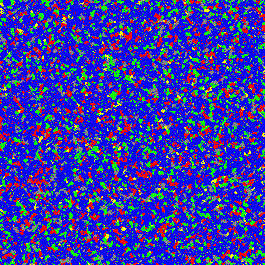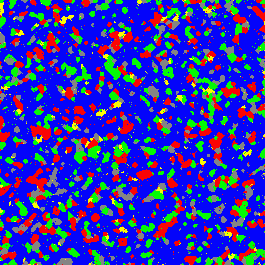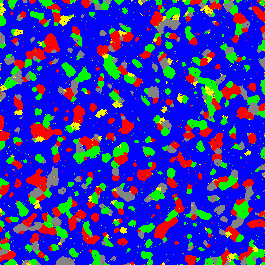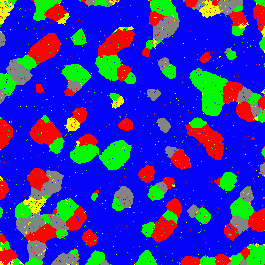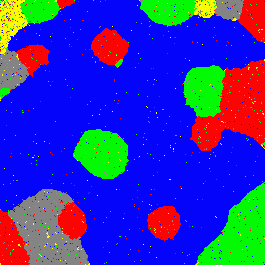Simulation of Ethnic Group Residential Patterns in Metropolis
Back to main Chromatism page
 The console Metropolis is a medium-sized simulated city (with a population of just over 70,000 families), and has five distinct ethnic groups: Blues, Reds, Greens, Grays, and Yellows. We make the reasonable assumption that people in each ethnic group, when choosing their residence, have a modest preference for their own group: they would prefer that at least 50% of their immediate neighbors be of the same ethnic group. The purpose of the model is to see how quickly these preferences produce residential segregation. Additional assumptions are that each family moves on the average of once every eight years, and that each may choose to live within any currently available housing unit in the city. At the beginning of the process, the families from each ethnic group are distributed evenly throughout the city on a random basis. An algorithm using the assumptions given above operates every eight days, randomly selecting the appropriate number of families to move and then casting about among their residences for the most appropriate new site for each family, according to their given preferences. If a residence matching the preference of a family cannot be found, it is put in the nearest match possible. You will find that the different groups congregate relatively quickly in their separate enclaves -- within about ten years. It is important to note that this occurs without any assumption of discrimination by one group against another! All that is required is that each group have a modest preference for its own kind. One of the counter-intuitive results is that the preferences of the dominant majority do not make as much difference as the preferences of the minorities. Blues are the largest group (about 65%), so that they will tend to have mostly Blues for neighbors, no matter their preferences. But the preference of a small minority will cause its families to clump quickly into segregated neighborhoods. You may change the pattern of residence by changing the preference of one or more groups. If you make a group less inclined to choose its own for neighbors, you will still find the enclaves forming, but at a slower rate. We suggest that you try removing preferences (making them zero) for all groups but one -- and that one group will still have its "ghetto"! The nature of the pixel grid means that each family can have only eight immediate neighbors (above, below, left, right, and four catty-corners). Thus the preferences allowed are the eighths, i.e. 0%, 12.5%, 25%, 37.5%, 50%, 62.5%, 75%, 87.5%, and 100%. If you change any of the percentages for an ethnic group, it will round to the nearest eighth. Try it for different percentages and see what happens! Let it run for thousands of years and watch the ethnic enclaves form -- Redtown, the Green Barrio, Little Yellowland, etc. To download a freeware version of the Ethnic Simulator, click here. Save the zip file to your computer, open it, and run "Setup", using all the default settings. "Natintel Ethnic Simulator" will then be listed in "Programs" on your Start Bar. If you have questions, email me at this address. -- Ned May |
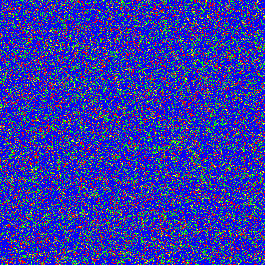 Start
|
